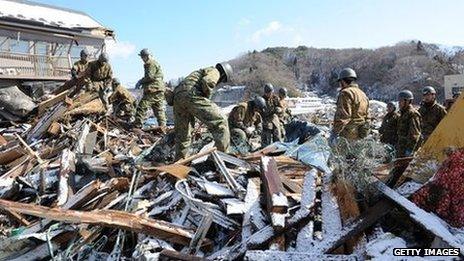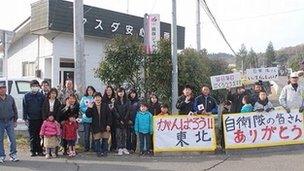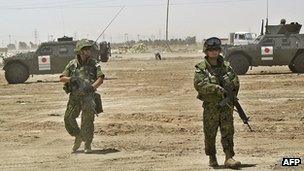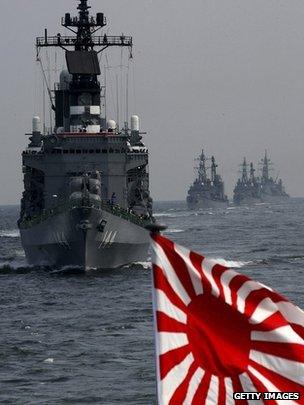Japan's contradictory military might
- Published

Soldiers of Japan's Self Defence Force search for victims buried under debris after last year's quake
Within a week of the earthquake and tsunami that devastated parts of north-east Japan, more than 100,000 Japanese servicemen and women were involved in rescue efforts on the ground.
The government says they saved 19,286 lives - almost as many as those who have died or are still missing following the disaster.
Under the post-war constitution, Japan is not allowed to have offensive military forces.
Its Article 9 declares "the Japanese people forever renounce war as a sovereign right of the nation and the threat or use of force as means of settling international disputes".
Public approval
So the stated purpose of the military - known as the Self Defence Force (SDF) - is "to preserve Japan's peace, independence and safety".
It impressed the public in the aftermath of the March quake last year.
"I saw their trucks yesterday heading to the northeast. I wanted to scream - good luck!" one tweet from sacura_haruca said on 14 March.
"I'm on the brink of tears looking at the photos of the Self Defence Force," said another, named immoyabletype. "The non-combat army - they are super cool."
And that is the image that the Japanese government is keen to portray - a home-based army which poses no threat to anyone abroad.
But there are contradictions. The SDF - described in the constitution as "the minimum level of armed strength for self-defence necessary" - is the world's sixth-best funded army, according to the International Institute for Strategic Studies.
Its budget is capped at 1% of Japan's gross domestic product but when the country is the world's third-largest economy, this small proportion of it is still 4.6 trillion yen ($55.9bn; £35.8bn).
Its servicemen are highly trained and the hardware they use is sophisticated.
Naval strength
"The quality of its operations in the areas of surveillance, disaster relief, mine sweeping and reconstruction are the world standard," says Assistant Professor Ken Jimbo from Keio University.
Roughly two-fifths of the budget is spent on ground forces and the rest split between maritime and air forces, according to Professor Christopher Hughes of the University of Warwick.
"Since the end of the Cold War, Japan's security policy has been shifting to increase its capability to defend itself outside its own territory and to send the force further afield," he says.

Earthquake survivors express their gratitude to the Self Defence Force
"It denies itself the most powerful weapons so it doesn't have offensive capabilities - such as ballistic missiles - but Japan's maritime SDF, for example, is one of the leading navies in the world after the US," he says.
Whether the military is battle-ready is another question. After all, since the end of World War II, no Japanese soldiers have engaged in actual combat.
Assistant Professor Jimbo says Japan's readiness depends on the scale of any attack.
"For example, the Self Defence Force can operate missile defences against North Korea's missile attacks or limited landing operations against Japan."
"But if the situation becomes more complex and with higher intensity, this is where the US-Japan alliance comes in," he says.
Changing operations
Under the decades-old Treaty of Mutual Cooperation and Security, the US guarantees Japan's security in the event of a military attack.
Japan, in exchange, hosts US troops in the country - mainly Okinawa - spending 188 billion yen ($2.3bn, £1.45bn) annually.
The evolution of SDF operations has for many years been closely tied to US policy. Only 20 years ago, it was not allowed to deploy overseas at all.

Japan's military sent personnel to Iraq after the 2003 invasion
Today SDF personnel are in places like Haiti, helping local people recover from the earthquake. They are also off Somalia to protect vessels from pirates and even deployed for a short time to Iraq.
The change began in 1992 when lawmakers passed the Peacekeeping Operations Law to allow Japan to participate in United Nations operations abroad, in response to criticism for failing to send troops during the first Gulf War.
A decade later in 2003, the Iraq War began and the US asked its allies for help.
The government passed a special law allowing a limited deployment - a controversial move that many thought was unconstitutional.
In the end, nearly 1,400 SDF personnel were sent to Iraq between March 2003 and February 2009 to take part in reconstruction work.
Major General Goro Matsumura led the third deployment of 600 soldiers, in 2004.
"More than 90% of my team members had never been deployed overseas," he tells the BBC.
"Before we left, we had no idea what it was like on the ground so many of them expressed their concern but once we got there we were warmly welcomed, so we were relieved."
For many, it was the first time they experienced the possibility of being attacked.
"There were two incidents where we came under rocket fire at night in October and November - though luckily they didn't explode," Maj-Gen Matsumura says.
'Politically important'
He says he was under unspoken pressure not to lose anyone on the ground.
"No Self Defence Force personnel have ever been injured or killed on missions so I needed to be well prepared not to let any accidents happen in Iraq."
Associate Professor Narushige Michishita of the National Graduate Institute for Policy Studies says the deployment was "more a politically important symbolic gesture to the United States and other allied nations than a real military contribution".

Japan's naval defence forces are considered one of the world's most capable
He described it as an "important learning process" for the SDF but says "because the right to use force was restricted, the significance of their contribution was also limited".
Amid concern over China's military spending and US realignment in the region, the debate over the constitution rumbles on.
Some lawmakers say it should be changed to allow Japan more freedom to act on the international stage.
"What kind of a fool keeps the same constitution that occupation troops forced upon us 65 years ago," asks Tokyo Mayor Shintaro Ishihara. "We should ditch the current constitution and start afresh."
Assistant Professor Jimbo, however, says a few changes should suffice.
"Japan needs to lift rules such as the prohibition on exercising collective self-defence (defending other allied forces)," he said.
"For example in Samawah [in Iraq], Dutch, British and Australian forces who shared responsibility for the area pledged to help the Self Defence Force in case of an emergency but not vice-versa."
But there is low public support for changes to the status quo.
So for now the contradictions will remain for the modern, well-funded army that prefers to stay within its own borders.